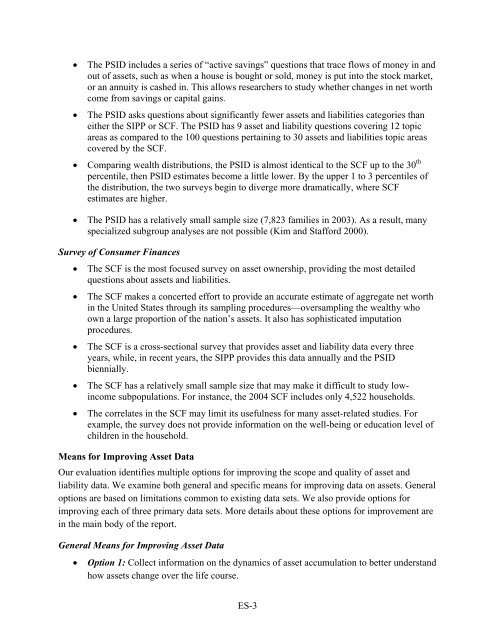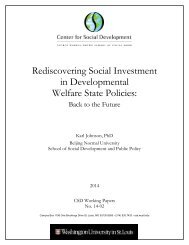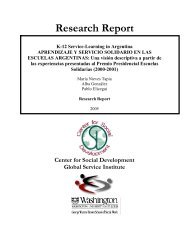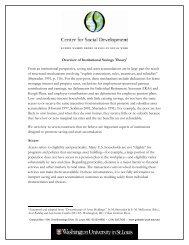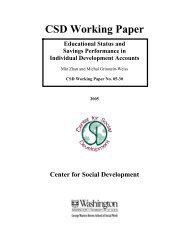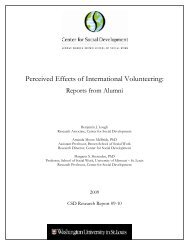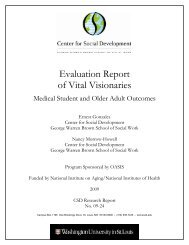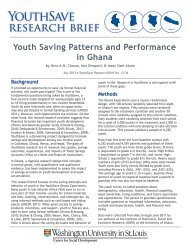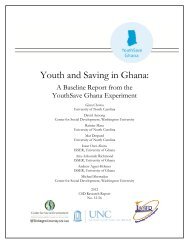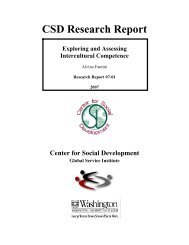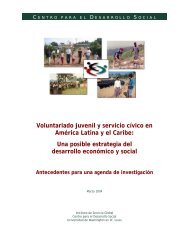Assessing Asset Data on Low-Income Households - Urban Institute
Assessing Asset Data on Low-Income Households - Urban Institute
Assessing Asset Data on Low-Income Households - Urban Institute
You also want an ePaper? Increase the reach of your titles
YUMPU automatically turns print PDFs into web optimized ePapers that Google loves.
• The PSID includes a series of “active savings” questi<strong>on</strong>s that trace flows of m<strong>on</strong>ey in and<br />
out of assets, such as when a house is bought or sold, m<strong>on</strong>ey is put into the stock market,<br />
or an annuity is cashed in. This allows researchers to study whether changes in net worth<br />
come from savings or capital gains.<br />
• The PSID asks questi<strong>on</strong>s about significantly fewer assets and liabilities categories than<br />
either the SIPP or SCF. The PSID has 9 asset and liability questi<strong>on</strong>s covering 12 topic<br />
areas as compared to the 100 questi<strong>on</strong>s pertaining to 30 assets and liabilities topic areas<br />
covered by the SCF.<br />
• Comparing wealth distributi<strong>on</strong>s, the PSID is almost identical to the SCF up to the 30 th<br />
percentile, then PSID estimates become a little lower. By the upper 1 to 3 percentiles of<br />
the distributi<strong>on</strong>, the two surveys begin to diverge more dramatically, where SCF<br />
estimates are higher.<br />
• The PSID has a relatively small sample size (7,823 families in 2003). As a result, many<br />
specialized subgroup analyses are not possible (Kim and Stafford 2000).<br />
Survey of C<strong>on</strong>sumer Finances<br />
• The SCF is the most focused survey <strong>on</strong> asset ownership, providing the most detailed<br />
questi<strong>on</strong>s about assets and liabilities.<br />
• The SCF makes a c<strong>on</strong>certed effort to provide an accurate estimate of aggregate net worth<br />
in the United States through its sampling procedures—oversampling the wealthy who<br />
own a large proporti<strong>on</strong> of the nati<strong>on</strong>’s assets. It also has sophisticated imputati<strong>on</strong><br />
procedures.<br />
• The SCF is a cross-secti<strong>on</strong>al survey that provides asset and liability data every three<br />
years, while, in recent years, the SIPP provides this data annually and the PSID<br />
biennially.<br />
• The SCF has a relatively small sample size that may make it difficult to study lowincome<br />
subpopulati<strong>on</strong>s. For instance, the 2004 SCF includes <strong>on</strong>ly 4,522 households.<br />
• The correlates in the SCF may limit its usefulness for many asset-related studies. For<br />
example, the survey does not provide informati<strong>on</strong> <strong>on</strong> the well-being or educati<strong>on</strong> level of<br />
children in the household.<br />
Means for Improving <str<strong>on</strong>g>Asset</str<strong>on</strong>g> <str<strong>on</strong>g>Data</str<strong>on</strong>g><br />
Our evaluati<strong>on</strong> identifies multiple opti<strong>on</strong>s for improving the scope and quality of asset and<br />
liability data. We examine both general and specific means for improving data <strong>on</strong> assets. General<br />
opti<strong>on</strong>s are based <strong>on</strong> limitati<strong>on</strong>s comm<strong>on</strong> to existing data sets. We also provide opti<strong>on</strong>s for<br />
improving each of three primary data sets. More details about these opti<strong>on</strong>s for improvement are<br />
in the main body of the report.<br />
General Means for Improving <str<strong>on</strong>g>Asset</str<strong>on</strong>g> <str<strong>on</strong>g>Data</str<strong>on</strong>g><br />
• Opti<strong>on</strong> 1: Collect informati<strong>on</strong> <strong>on</strong> the dynamics of asset accumulati<strong>on</strong> to better understand<br />
how assets change over the life course.<br />
ES-3


